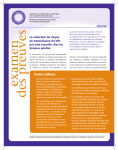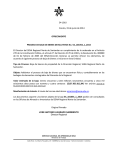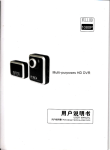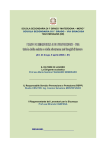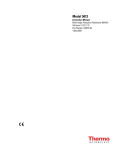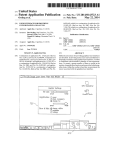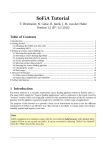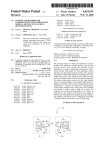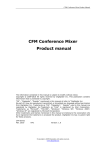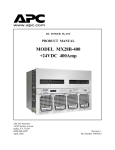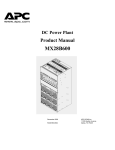Download Troubleshooting engine and method for using same
Transcript
US 20030065967A1
(19) United States
(12) Patent Application Publication (10) Pub. No.: US 2003/0065967 A1
(43) Pub. Date:
Garcia et al.
(54) TROUBLESHOOTING ENGINE AND
(52)
Apr. 3, 2003
Us. 01. ................................................................ .. 714/1
METHOD FOR USING SAME
(76) Inventors: Joel Garcia, San Diego, CA (US);
Craig Arnush, San Diego, CA (US);
Balan Tholandi, San Diego, CA (US);
Je?' Mazon, San Diego, CA (US); Luc
Tran, San Diego, CA (US); J. Dilan
Celi, San Diego, CA (US)
Correspondence Address:
NOVAKOV DAVIS & MUNCK
A PROFESSIONAL CORPORATION
Docket Clerk
PO. Box 802432
DALLAS, TX 75380 (US)
(57)
ABSTRACT
A system for using a troubleshooting engine to assemble an
interactive multimedia repair guide for assisting a service
technician in the repair of a defective product, and a mehof
of using the same. The system includes a dynamic knoWl
edge database for storing product history records relating to
defects reported concerning the product. The database also
contains design information related to the product for cor
relation With the defect reports and use in analyzing future
reported defects. The integrated quality management system
also includes a product performance counter (PPC) analysis
(21) Appl. No.:
09/967,874
module that receives PPC data from an individual product,
generates a PPC pro?le based on the received data, and
(22) Filed;
Sep_ 29, 2001
pro?les to produce a Weighted prediction report of likely
Publication Classi?cation
defects. This report is transmitted to the troubleshooting
engine, Which directs a multimedia application to transmit
diagnosis and repair instructions to a service center techni
(51)
Int. Cl.7 ..................................................... .. H02H 3/05
compares the pro?le to stored design and historical PPC
cian.
/
PM,
ANALJ-[Slg
Moi) up?
ENGMIE'
Patent Application Publication
Apr. 3, 2003 Sheet 1 0f 3
US 2003/0065967 A1
)00
/
DA‘TAk 6M E
TROMLE SMG'WV G
‘EPIGMIE'
NE‘VLAORR
Po'S
, 5M
_________.__-—’
Patent Application Publication
Apr. 3, 2003 Sheet 3 0f 3
US 2003/0065967 A1
/ 40!
PFC
AMA-WW5
Moavwr’
commm cA'nod
‘
MO 'GmuE.
/
SETQIBJ
A $5 7
34 O
M ‘30 \LLE
{
i
x01
a
q
330 f
*-
m
3
“Mm-1
Z00
F/MMQE 3
________._
Apr. 3, 2003
US 2003/0065967 A1
TROUBLESHOOTING ENGINE AND METHOD
FOR USING SAME
[0001] This invention relates generally to the service and
repair of defective products, and more speci?cally to a
system and method for the providing a netWork-based
interactive multimedia repair guide for use in addressing
reported product defects at remote service facilities.
BACKGROUND OF THE INVENTION
[0002] For many mass-market, that is, very Widely-dis
tributed consumer products, the chain of product develop
attempt may ?rst be made at a quick repair. To do this, an
accurate description of the defect must be given, and an
appropriate ?x performed. Note, hoWever, that in most, if
not all, cases, the consumer Will report only symptoms of a
defect—the unacceptable performance they encountered.
They have little or no Way of actually determining the root
cause of this unacceptability, that is, the actual defect. Not
being experts, consumers may be susceptible to misreport
ing symptoms of the defect, making diagnosis all that more
dif?cult. Moreover, customers Who Wish to return products
may intentionally misreport problems out of a fear that their
ment, design, production, and distribution folloWs a familiar
pattern. The pattern is folloWed because sales of hundreds,
return for other reasons Will not otherWise be accepted. And
of course, With most defects in electronics devices, the
presence or absence of a defect is not normally easy to
even thousands of the same or very similar products are
identify by simple visual inspection.
expected to be sold through a great many retail stores.
Products are designed by one group of people, manufactured
by others—perhaps even a different company entirely—and
then shipped for distribution and sale. Distribution is usually
through regional, then local distribution centers, and ?nally
to the retail outlets Where they Will be sold. In this type of
market, the people at one end of the chain often have very
little direct contact With those at the other. In any such
scheme, a certain number of product defects of uncertain
origin are likely to go undiscovered until they appear at the
retail level, either before or after the product is sold to a
consumer. A customer Who discovers a product defect can
[0006]
Ultimately, this means that doZens, even hundreds
of technicians are forced to address problems and cure
defects occurring in products that that they had no part in
creating and that many times they may be only generally
familiar With. Moreover, because thousands of units of a
product may be manufactured and shipped in a short period
of time, there is a high probability that many of these
technicians are independently addressing the same defects as
other, distant technicians, and independently having to dis
cover the same or similar solutions.
not possible knoW Where in the chain the defect originated,
so problems perceived at this level are generally ?rst dealt
[0007] Reported defects may be real, or result from the
consumer’s unrealistic expectations or inability to properly
operate the product. Real defects include both those endemic
With the retail outlet Where the item Was purchased or a local
to the entire line of products—perhaps due to a design or
service center. Unfortunately, these members of the chain
manufacturing ?aW—and those related only to certain indi
are the ones most distant from the design and manufacturing
groups Where the defects Were very likely introduced.
vidual products, or a relatively small set of the total number
[0003] Moreover, mass-market products are ubiquitous in
manufactured. Whatever the type or origin of the defect (this
term herein meant to include both real and imagined defects
the modern World. Where once a single electrical device
such as a radio, television, or telephone might be among a
family’s most priZed possessions, many homes are noW
unless otherWise speci?ed or apparent from the context), the
myriad and scattered service technicians Will have to address
it With little outside guidance, at least initially. Although
?lled With literally doZens of such devices. Correspondingly,
these technicians are free to call others, or to contact the
the number of retail outlets at Which electrical devices such
engineers or factory representatives, they cannot ef?ciently
as mobile phones, personal digital assistants (PDAs), cal
engage in extensive research and study to determine the
cause each and every reported problem and Work out opti
culators, computers, DVD players, and the like, are sold has
also increased dramatically. Such retail outlets may no
longer specialiZe in a particular line of electrical devices, but
may sell them as part of a Wide selection of household
goods.
[0004] A typical feature of modern retailing, hoWever, is
the consumer’s ability to bring a previously-purchased prod
uct back to the retailer and obtain a refund of the purchase
price or some other consideration. This Works to the con
sumer’s advantage especially When a defective product has
been purchased. It may also Work to the advantage of the
mum solutions. As a result, there exists little or no easy Way
to ef?ciently bene?t from the experiences of others.
[0008]
One Way in Which this issue has been addressed is
through What may be referred to as a “reporting and bulletin”
system. Over the life of a commercial product, any problems
commonly encountered are usually reported to a central
service site. The problem report may include not only a
description of the problem, but a proposed solution or
suggestion as Well. Or the central service facility may
analyZe common defects in an effort to come up With an
manufacturer When, instead of employing extensive (and
appropriate Way to address them. When suf?cient data has
expensive) measures to ensure every device is in perfect
Working order, an easy return or exchange process means
service technicians to provide them With guidance on hoW to
that a higher number of defective products may be accept
able to the public at large. Returned products are not simply
scrapped, hoWever. Some can be repaired and resold, pre
sumably having been restored to the originally-intended
level of quality. And some “returns” are not defective at all,
but simply returned because they did not meet the custom
accumulated, a service bulletin can be issued to all of the
deal With the particular problem covered in the bulletin.
[0009] Unfortunately, this method, hoWever reliable, is
often too sloW to react to problems encountered With neWly
released products, especially in industries Where neW
releases are frequent. Only after suf?cient time has elapsed
ers’ needs for other reasons.
Will enough service bulletins have been issued to cover the
vast majority of problems that are likely to be encountered.
[0005] Returns are not Without cost, hoWever, When a
customer brings back a product and claims it is defective. An
When a product (and the defects endemic to it) is very neW,
there is still very little to report in a service bulletin, and the
Apr. 3, 2003
US 2003/0065967 A1
collection and dissemination process does take a certain
assembling the repair guide. Information gathered during
amount of time. As a result, situations arise frequently where
execution of the repair process is provided to the database so
that the historical data may be supplemented.
an unknown defect is reported at a service center, and has to
be handled without bene?t of the collective experience that
the service bulletins represent. This will remain the case
BRIEF DESCRIPTION OF THE DRAWINGS
until a quantity of experience has been amassed, reported,
and incorporated into a service bulletin. This time delay,
however, is unacceptable in industries such as the present
wireless telephone industry, where new product releases
occur very frequently. In such industries, the state of the
underlying technology often advances so fast that even
products released in the past one or two years are nearing
obsolescence. By the time that recurring problems have been
[0015]
FIG. 1 is a block diagram of an intelligent distrib
uted service system incorporating the troubleshooting
engine according to an embodiment of the present invention;
[0016] FIG. 2 is a How chart illustrating an embodiment
of a distributed service system repair process according to an
embodiment of the present invention; and
sufficiently documented and solutions proven, it is very
nearly time for release of the next generation of products.
[0017] FIG. 3 is a block diagram illustrating the major
components of an exemplary troubleshooting engine con
?gured in accordance with an embodiment of the present
[0010] Needed, then, is an inexpensive and ef?cient
method of rapidly developing a centraliZed database, along
with an intelligent problem-solving routine to enable widely
invention.
distributed service centers to more quickly and ef?ciently be
able to handle problem reports, especially those associated
with a new product release.
SUMMARY OF THE INVENTION
[0011]
It is an object of the present invention to provide an
ef?cient problem-resolution system and methodology usable
by service technicians for assistance in the repair of defec
tive products.
[0012]
In one aspect, the present invention is a trouble
shooting engine including a multimedia session assembly
module for assembling an interactive multimedia repair
guide. The troubleshooting engine further includes a com
munication module for communicating with the service
technician to receive information related to the defective
product, a memory device for storing at least some of the
received information so that it can be referred to when
assembling the repair guide, and a multimedia library from
which to draw prepared multimedia materials that may be
used in multimedia repair guide assembly.
[0013]
In another aspect, the present invention is a dis
DETAILED DESCRIPTION OF THE
INVENTION
[0018] FIGS. 1 through 3, discussed below, and the
various embodiments used to describe the principles of the
present invention in this patent document are by way of
illustration only and should not be construed in any way to
limit the scope of the invention.
[0019] FIG. 1 is a block diagram of an intelligent distrib
uted service system 100 incorporating a troubleshooting
engine 301 according to an embodiment of the present
invention. Note the present invention is directed both to a
troubleshooting engine speci?cally, and as well to its appli
cation in a system such a distributed service system 100.
Distributed service system 100 includes dynamic knowledge
database 101, which is a constantly updated knowledgebase
of information relating to previously encountered defects
(again, real and imagined) along with both proposed, and
proven solutions for addressing them. Knowledge database
101 is updated both automatically by system 100 and
manually by engineers and service personal as new prob
lems are encountered and their solutions developed.
Dynamic knowledge database 101 is preferably an orga
tributed service system having a troubleshooting engine in
niZed database of an organiZation’s entire collective reme
communication with a database for storing historical repair
dial-action experience. In part this experience is documented
and product design information that the troubleshooting
and collected as in the past, by service technicians generat
ing defect reports that are submitted to a central department
engine may refer to in preparing a repair guide for use by a
service technician attempting to perform repairs on a defec
tive product. The repair guide is preferably an interactive
multimedia repair guide, and information gathered during
the interactive repair session is used to supplement the
historical repair information in the database. In a particularly
preferred embodiment, the system also includes a PPC
analysis module for analyZing any PPC counts provided by
the defective product and fed to the PPC analysis module.
[0014] In yet another aspect, the present invention is a
method of assisting a service technician attempting to repair
a defective product that includes the steps of providing a
troubleshooting engine, collecting information related to the
product defect, transmitting the information to the trouble
shooting engine, and using the information to assemble an
interactive multimedia repair guide for transmission to the
service technician. The method may further include provid
ing an historical knowledge database in communication with
for analysis. In addition, however, certain information is
collected automatically as the repair process is interactively
guided by the by troubleshooting engine 310.
[0020] Complimenting dynamic knowledge database 101
is PPC analysis module 401. PPC analysis module 401
receives input obtained from the defective product itself,
including (though not limited to) the contents of a product’s
product-performance counters (PPCs). Armed with this data,
PPC analysis module 401 prepares a product pro?le based
on the PPC contents, and any other inputs it receives, and
compares this pro?le to others represented in the design and
collective-experience data in dynamic knowledge database
101. Based on this comparison alone, it may be possible to
determine precisely the cause of the reported problem,
although more likely a number of possible causes will be
identi?ed, each consistent with the received PPC data. Each
possible defect cause may be ranked, again with reference to
the troubleshooting engine for storing historical repair data
the knowledge accumulated on dynamic knowledge data
that also may be used by the troubleshooting engine in
base 101 to indicate if determinable which cause is most
Apr. 3, 2003
US 2003/0065967 A1
likely to be correct, then Which is next most likely, and so
shooting engine 301, and PPC analysis module 401 are
forth. In a particularly preferred embodiment, this ranking
includes a relative certainty value, indicating hoW much
preferable linked to one another and co-located. They may
actually reside in the same physical device and share its
more likely the defect is a result of one cause as opposed to
resources. The various POSs, on the other hand, are often
another. This ranking and, When present, an associated
certainty value may be reported to the service technician to
aid in their analysis. In this embodiment, When a certain
cause is associated With a suf?ciently high probability, any
other alternatives may simply go unreported, or may be
reported only on request. The service technician in this Way
remotely located and connected to the remainder of system
100 by communication netWork 201. This con?guration is
not required, hoWever, and in an alternate embodiment, a
can eliminate from vieW distracting and probably unneces
sary information. In another embodiment, the ranking and
certainty information is used only for the purpose of direct
ing repairs through the interactive service guide.
[0021]
Communication netWork 201 is a netWork connect
ing the PPC analysis module 401 and the various points of
service (POSs) such as POS 501, POS 502, and POS 503.
Communication netWork 201 is very likely to include the
Internet (and any necessary access channels), but may also
be, Where useful, a local area netWork (LAN), a Wide area
netWork (WAN), a virtual private netWork (VPN), or some
other public or private communication netWork. The greatest
advantage obtains, hoWever, When the communication net
POS (not shoWn) may be nearby and directly connected (or
even share the same physical unit). LikeWise, dynamic
knoWledge database 101, troubleshooting engine 301, and
PPC analysis module 401 may be remote located from one
another and, if so, may rely on communication netWork 201
as Well.
[0025] Turning to FIG. 3, there appears a block diagram
illustrating the major components of an exemplary trouble
shooting engine 301 con?gured in accordance With an
embodiment of the present invention. Troubleshooting
engine 301 includes a communication module 340 for
sending and receiving communications through the commu
nications netWork 201, through Which it maintains contact
With one or more POS (such as POS 501 shoWn here). Note
Work 201 selected is the most ef?cient and reliable Way to
connect the POSs and the other components of distributed
again that communications netWork 201 may include seg
ments of different communications netWorks, including the
Internet, a VPN, satellite netWork, or the like, that is capable
of handling multimedia communications betWeen trouble
service system 100. The Internet typically ful?lls these
criteria, but may not alWays be the optimum netWork. Of
communication channel Will be the one through Which the
shooting engine 301 and point of service 501. Generally, this
course, the netWork does not have to be either homogenous
or static, and separate POSs may access the rest of the
interactive multimedia repair guide session is conducted,
system by different and changing means.
[0022] Note that although three POSs are shoWn, there
one established through PPC analysis module 401, as nec
essary or desirable under the circumstances. Preferably,
could be any number; very likely there are doZens, even
hundreds. Some may be nearby, others distant. Some may be
relatively permanent, While others are mobile, occasional, or
purposefully in existence only for a short time. A POS may
even effectively be in more than one location (not shoWn),
such as Where a product brought into one location is being
remotely examined by a service technician in another. Natu
rally, the nature of the netWork connection to each POS
through communication netWork 201 may vary according to
although any other channel may be used as Well, for example
communications module 340 is capable of transmitting and
receiving through a variety of netWork con?gurations, and
may in fact be capable of quickly sWitching from one to
another if a certain channel is for some reason interrupted or
unavailable.
[0026] Troubleshooting engine 301 also includes a multi
media service manual assembly module 320, a multimedia
library 310, and current-repair ?le 330. When a problem
report is received and processed (see FIG. 2 and the
the aforementioned factors. In some instances, some or all of
discussion of it beloW), the results are sent to troubleshoot
the system 100 may be replicated for ease of access, or
provided on a removable storage media (such as a CD) for
ing engine 301, either through a direct connection if the
basic components of the distributed service system 100 (see
FIG. 1) are physically co-located With troubleshooting
engine 301, or through communications netWork 201. Any
use even if continuous communication is not possible or
desirable. Note also that certain POSs may be provided With
more or less service relative to others, or each permitted to
have access to only a certain amount of information. This
may be a useful limitation Where a particular POS also
services the products of competitors.
[0023] Troubleshooting engine 301 is at the heart of the
distributed service system 100 because it takes the informa
tion stored and generated by the other system components
and applies it to a process for assisting the service technician
Who is addressing the defective product. Speci?cally,
troubleshooting engine 301 receives the report produced by
PPC analysis module 401 and uses the defect-prediction
information contained in it, along With the design and
collective-experience information on database 101, to
assemble an interactive multimedia guide for use by the
service technician so that problems can be quickly diag
nosed and, Where possible, repaired.
[0024]
Note that in a preferred embodiment, such as the
one of FIG. 1, dynamic knoWledge database 101, trouble
other relevant information may also be sent to troubleshoot
ing engine 301 at this time if it has not already been
transmitted. This information is stored in current repair ?les
330. There may, of course, be many repair sessions being
conducted simultaneously, and current repair ?les 330 main
tain data relating to each of them for use by any of the
system 100 components as needed. Session assembly mod
ule 320, for example, uses this information to assemble an
interactive multimedia service manual customiZed for the
particular product being addressed, and for the defect symp
toms encountered (as reported or as generated by the PPC
analysis). Although current repair ?les 330 Will ordinarily
not themselves store all of the of the multimedia service
manual used in a given session, the ?les Will usually
maintain a record of What content has been transmitted to
point of service 501, and also the responses received in
return. (Note again that although only one point of service
is shoWn, there could be any number of them.) Processor 350
under the direction of control program 360 refers to current
Apr. 3, 2003
US 2003/0065967 A1
repair ?les 330 in order to properly direct the session
assembly module 320 in assembling the multimedia repair
session, for eXample by indicating Which suggestion to make
or What additional information to request. Finally, multime
It is in the interest of both consumer and service center,
hoWever, that a course of action be promptly decided on and
eXecuted.
[0030]
A returned product is ?rst connected With a device
dia library 310 contains various pre-developed multimedia
presentation content for use by session assembly module
320 in preparing an ongoing multimedia session.
that can read the PPC memory and report the various PPC
[0027] Turning noW to FIG. 2, there appears a How chart
illustrating an embodiment of a distributed service system
repair process 200 according to an embodiment of the
priate service-center terminal provided for the purpose. In an
alternate embodiment applicable to mobile phones and other
communicative products, the customer may be provided
present invention. Initially (START), it is presumed that
products are provided With product performance counters
(PPCs) either at manufacture or by retro?t. The “product”
With a number or electronic address to contact in the event
may be any type of product, but the process of the present
invention is most advantageously employed in connection
With mass-distribution consumer electronics products such
as mobile phones, computers, personal digital assistants
counts stored there (step 215). This Will frequently be a
connection established by a service technician to an appro
the product’s performance appears to be beloW an accept
able standard. In this embodiment, the product must, of
course, be Working Well enough to establish such contact.
When contact is made, the PPC count may be doWnloaded
through Whatever communication channel is being used
(PDAs), televisions, and similar products. (Large custom
(preferably after the customer somehoW indicates their per
mission to do so). In yet another embodiment, the device can
iZed products, in contrast, are less likely to be serviced in a
Widely-distributed service system.) A PPC is an internal
be connected to a properly con?gured personal computer
detector that can be used to detect the occurrence of a certain
event in the product, especially one that can be associated
With a given defect. The detector is associated With a counter
in non-volatile memory, Where the number of times a certain
event occurs is tracked. Atime and data stamp or clock time
may be associated With the PPC so that When an event
occurs can be tracked as Well, or at least its frequency as
related to device-operation time. A given device Will nor
mally have numerous PPCs, each tracking the occurrence of
different events. For eXample, in the mobile phone environ
and the PPC counts automatically transmitted over an Inter
net connection.
[0031] At step 220, a PPC algorithm, formulated for use in
analyZing the PPC counts When they are received, is applied
to the collected product counts and a result obtained. The
PPC algorithm may originally have been Written using
design speci?c action and predictive error analysis, but is
preferably updated on a regular basis to adjust for experi
ment, PPCs can be used to measure events such as dropped
ence. In a preferred embodiment, the system 100 is capable
of updating the algorithm automatically based on the results
of sessions conducted and any other data With Which it is
calls, access-attempt failure, softWare and hardWare resets,
provided. As described above, the result preferably includes
and origination failures. Each of these events is a symptom,
both a list of possible defects corresponding to these col
lected data, and a probability of accuracy estimate associated
With each of the listed defects.
of course, and not an actual defect. In combination With
statistics related to device operation, such as call and
standby time, minutes being recharged, etc., hoWever, PPCs
can be used to construct a pro?le of the device’s operational
life.
[0028] As mentioned above, a PPC-based pro?le is used in
the diagnostic portion of the quality control process by
comparing it to an analogous pro?le for a device knoWn to
be defect-free, or to pro?les of devices having a knoWn
defect. Based on this analysis alone, it may be possible to
predict With a measurable amount of certainty the root cause
of a problem. Again, PPCs cannot detect defects directly, but
can be used to statistically predict What the defect Will be, or
at least provide a course of action most likely to ?nd the
defect and result in an effective repair.
[0029] Step 205, data accumulation, generally occurs in all
PPC-equipped devices, both satisfactory and defective,
While they are in the user’s (or in some instances, the service
technician’s) possession. The PPC counts are stored in
memory until it is full, then neW count data is added to
memory by discarding selected portions of the data already
stored. Step 210 occurs When a product is returned for repair,
or alternately When initiated by a customer. Note that
products may be returned to the seller for a number of
different reasons. One reason, of course, is a real defect that
the user Wishes to have remedied. At this point, it is usually
unknoWn Whether the product Will be repaired or replaced,
or hoW long any potential repairs Will take. Even if a
customer accurately and truthfully reports the problems With
operating the product, the determination is not easily made.
[0032] At step 225, the troubleshooting engine 301
receives the results of the PPC analysis in What may be
referred to as a PPC analysis report. This report generally
comes from the PPC analysis module 401, but may also be
received from the dynamic knoWledge database 101 if it Was
previous compiled and stored there. At this step any other
relevant information, such as the defective product report, is
also provided unless it has already been transmitted. Note
that the defective product report comes largely from the
customer, possible one interacting With a service technician,
that has been put into a recogniZable form for use by the
troubleshooting engine 301. Depending on its sophistica
tion, of course, the troubleshooting engine 301 may use
input only from a simple form ?lled out on a computer,
audio responses to standard questions, or it may be able to
accept “natural language” reports in either teXt or audio
form, or perhaps a through a combination of any of these
methods.
[0033] Note that as the process 200 is being eXecuted, the
service technician may be given the option to terminate it
and simply proceed based on the information provided to
that point (step not shoWn). This option may be useful Where
an obvious solution has become apparent. Assuming this
does not occur, hoWever, at this point the troubleshooting
engine 301 performs initial assembly of a multimedia pre
sentation for the guidance of the repair technician in starting
the repair process (step 230). Note that for convenience
herein, “repair” Will mean diagnosis, repair, replace and
Apr. 3, 2003
US 2003/0065967 A1
return product to factory, and related operations. Also, While
the disclosure is made using the example of a repair tech
nician in a service center, it applies as Well to another in a
different location, for example, a consumer using a Wireless
connection involving the product itself in order to transmit
PPC data, and a personal computer connected through the
internet to receive multimedia instructions. In this sense
“service technician” refers to anyone performing a “repair”.
although in this case it may be preferable to also maintain an
un-amended version for comparison.
[0037] Note that the sequence provided above is exem
plary, and the steps of process 200 can be performed in any
logically consistent order. For example, the multimedia
session may begin immediately With a standard introduction,
Which guides the user through ?lling out an initial defect
report and PPC count doWnload process. Note also that not
[0034] The assembly of the multimedia process begins, of
all of the steps Will need to be performed for each repair, for
course, based on the information originally provided to the
example PPC counts may not be needed Where the defect
troubleshooting engine 301. It Will almost alWays include an
interactive portion to elicit responses to speci?c questions
meant to inform the repair process. As With the initial report,
report appears to adequately de?ne the problem.
these responses may be in any usable form. Once the initial
portion of the multimedia presentation is assembled, it is
transmitted to the service technician (step 235). The service
technician then begins to act on the information and supply
the responses required. At the very least, the service tech
nician Will presumably respond that the issue has been
[0038] The embodiments described above are preferred
examples for implementing the invention, and the scope of
the invention should not necessarily be limited by this
description. The scope of the present invention is de?ned by
the folloWing claims.
In the claims:
1. A troubleshooting engine, comprising:
resolved. The resolution may or may not have been reached
With the aid of the troubleshooting engine, but at such time
the multimedia session is no longer required. As the service
technician responds to the multimedia guide’s queries, the
a communication module for receiving repair information
relating to a product being repaired by a service tech
nician;
responses are transmitted back to the troubleshooting engine
(either as they are made, or in a batch after a group of queries
a memory device in communication With the communi
cation module for storing at least some of the received
have been addressed).
[0035] The troubleshooting engine 301 receives the ser
an assembly module for assembling a customiZed elec
vice technician’s responses (step 240), and adds them to the
data ?le 330 storing information related to the product
Whose repair is in process. It also uses the information, either
repair information; and
tronic repair guide based on the stored repair informa
tion, the repair guide for transmitting to the service
repeated as often as necessary. If, at any time in the received
technician and use in executing the repair.
2. The troubleshooting engine of claim 1, Wherein the
repair guide is a multimedia repair guide.
3. The troubleshooting engine of claim 2, further com
prising a multimedia library for storing pre-recorded multi
media materials that may be used by the assembly module
responses (step 240), there is an indication that the repair is
in assembling the multimedia repair guide.
complete, the process moves on to completion and folloW
4. The troubleshooting engine of claim 1, Wherein the
repair guide is an interactive repair guide.
5. The troubleshooting engine of claim 1, Wherein the
by itself or cumulatively With other stored data, to add to or
amend the multimedia guide session (step 245). The revised
or supplemented guide is then transmitted back to the
service center (step 235). Steps 240, 245, and 235 are
up (step 250). Here, the repair operation is closed-out,
preferably including an analysis of the information stored in
the current repair data ?les to make sure it is complete. If
not, a folloW-up form is transmitted to the service center
(return to step 235). Here also the process steps 240,
electronic repair guide is transmitted to the service techni
cian through the communication module.
6. The troubleshooting engine of claim 1, Wherein the
communication module receives the repair information
receiving a response from the service technician, 250 session
completion, and 235 transmitting additional information to
through a communications netWork.
the service center, may repeat as many times as necessary. In
some presumably rare instances, a response received at step
communications netWork is the Internet.
240 Will result in a re-opening of the repair process. When
it is determined at step 250 that the process is completed, the
session is completed and any appropriate historical infor
mation is stored in the dynamic knoWledge database (step
7. The troubleshooting engine of claim 6, Wherein the
8. A distributed service system for assisting service tech
nicians in performing repairs on a product, comprising:
a database for storing historical information related to
255).
making repairs on product, the historical information
[0036] In another embodiment (not shoWn) the service
technician is regularly provided With (or may request) the
opportunity to manually enter observations and suggestions
service technician after performing repairs on another
as the repair is being conducted. These may be used for the
current session only or saved and applied to the knoWledge
database 101. Any repair report being submitted may of
comprising product repair information reported by a
product similar to the product being repaired; and
a troubleshooting engine in communication With the data
base for receiving repair information from the service
technician and assembling a repair guide based at least
course be submitted in the multimedia session itself. In one
in part on the received information and on the historical
embodiment, the events of the current repair session are
stored and automatically used to generate a report, or
inserted into a report form that is then presented to the
service technician for revieW. The report as presented may
information stored in the database.
then be amended or supplemented by the technician,
9. The system of claim 8, further comprising a product
performance counter (PPC) analysis module for receiving
PPC counts from the product and using them to assemble a
PPC report, Wherein the troubleshooting engine is in com
Apr. 3, 2003
US 2003/0065967 A1
munication With the PPC analysis module to receive the PPC
generating a PPC pro?le using the PPC count; and
report and assembles the repair guide at least in part based
on the received PPC report.
10. The system of claim 8, Wherein the repair guide is an
interactive multimedia repair guide.
11. The system of claim 10, Wherein the interactive
multimedia repair guide prompts the service technician
executing the product repair to provide information for a
repair report.
using the PPC pro?le to prepare the repair guide.
15. The method of claim 14, Wherein the data stored in the
database includes at least one reference PPC pro?les corre
sponding to knoWn defects in a product, and Wherein the
step of using the PPC pro?le to prepare a repair guide
includes the step of comparing the PPC pro?le to the at least
12. The system of claim 10, Wherein the repair report is
one reference PPC pro?le to determine if they are similar.
used to supplement the historical information stored on the
database.
13. Amethod of assisting a service technician in the repair
16. The method of claim 13, further comprising the step
of comparing the received repair information to the data
of a defective product using a multimedia guide, comprising
the steps of:
defect cause.
collecting data related to reported defects in products that
the service technician is eXpected to repair and storing
the data in a database;
providing a troubleshooting engine for receiving repair
stored on the database to determine at least one possible
17. The method of claim 16, Wherein the comparing step
results in the determination of a plurality of possible defect
causes, and further comprising the step of assigning a
predicted likelihood that any one of the possible defect
causes Will prove to be the cause of the defect in the product
related information from the service technician and
being repaired similar.
using it to prepare the multimedia repair guide for
18. The method of claim 17, Wherein the multimedia
repair guide consists of a number of separate segments to be
presented in a particular order, and Wherein the particular
presentation order is determined at least in part by the
transmission to the service technician that is tailored to
the received information, Wherein the repair guide is at
least in part based in the data related to reported defects
stored in the database.
14. The method of claim 13, Wherein the repair-related
information includes at least one PPC count, and further
comprising the steps of:
predicted likelihood assigned in the assigning step.










